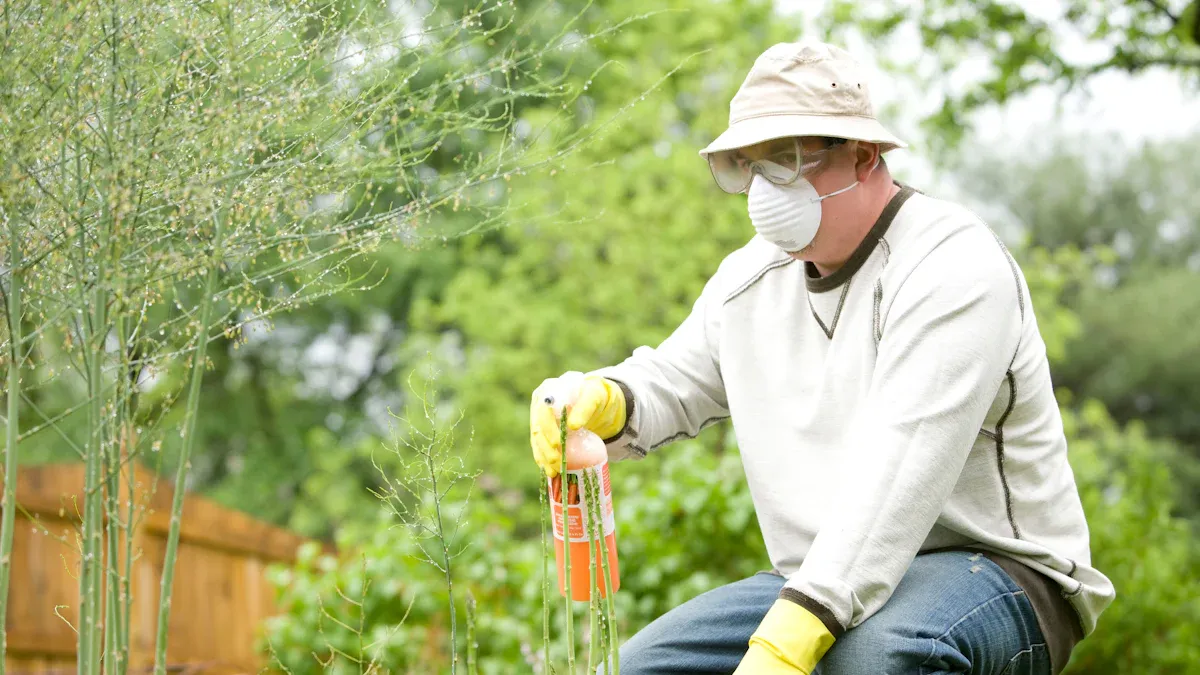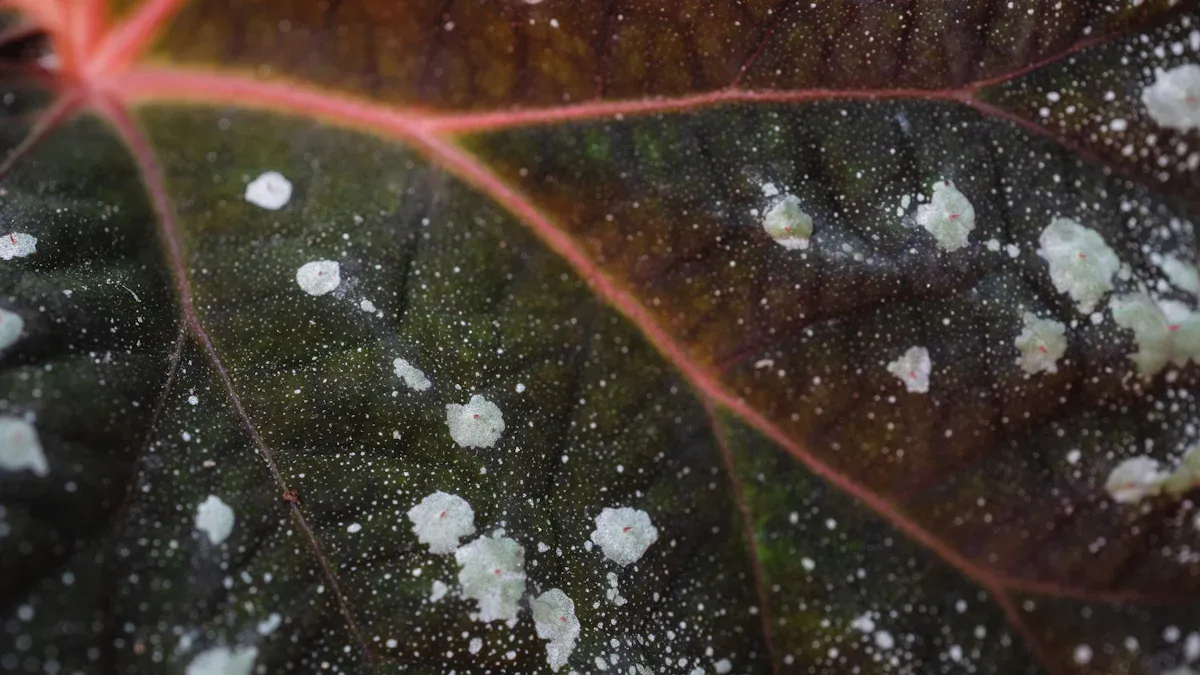
Mold on cucumber plants can be a real threat to your garden, and it’s essential to know how to get rid of mold effectively. It hurts plant health and can lead to significant yield losses—up to 100% in severe cases! You might notice signs like white powdery spots or wilting leaves. If you spot these issues, don’t wait! Taking action quickly to get rid of mold is crucial to saving your plants.
Key Takeaways
Identify mold types early. Look for white powdery spots for powdery mildew and yellow-brown spots for downy mildew. Early detection helps save your plants.
Practice good watering habits. Water your cucumber plants in the morning to keep leaves dry and reduce mold risk. Avoid overwatering to promote healthy growth.
Use effective removal methods. Cut off infected leaves and apply a milk or baking soda spray to treat mold. Repeat treatments every 5-7 days if needed.
Identify Mold on Cucumber Plants

When it comes to mold on cucumber plants, knowing what you’re dealing with is half the battle. Let’s dive into the common types of mold you might encounter and the symptoms that signal an infestation.
Common Types of Mold
You’ll likely come across two main types of mold affecting cucumber plants:
Downy Mildew: This mold is a significant concern for cucumber plants. You can identify it by water-soaked leaf spots that eventually turn yellow and brown. It spreads quickly through wind-dispersed spores, making it crucial to act fast if you spot it.
Powdery Mildew: This one is more common and appears as a white, talcum powder-like coating on the leaves. While it may seem harmless at first, it can hinder photosynthesis and stunt growth if left unchecked.
To help you distinguish between these two types, here’s a quick comparison:
Powdery Mildew | Downy Mildew |
|---|---|
Appears as individual, white fungal patches on the leaf’s surface | Identified by yellow and brown angular marks confined by the veins |
Fungal spots have a circular white appearance | Fungal spots have an angular and gray appearance |
Fungus can be anywhere on the leaf surface | Fungus is limited by leaf veins |
Leaves yellow after fungus has been present for a while | Leaves may yellow before the presence of fungus is even evident |
Symptoms of Mold Infestation
Recognizing the early signs of mold infestation can save your cucumber plants from severe damage. Here are some symptoms to watch for:
Initial Symptoms of Downy Mildew: You might notice angular yellow spots on the upper surfaces of older leaves. These spots often appear first on the lower leaves, so keep an eye on them.
Signs of Powdery Mildew: This mold typically starts on budding leaves, causing them to curl. As the infestation progresses, the upper surfaces become covered with a fine white to grayish powdery mycelial mass. If you see this, act quickly! Affected flower buds may fail to open, and leaves can become necrotic and fall off.
If you ignore these symptoms, the situation can worsen. For instance, downy mildew can lead to significant leaf yellowing before you even see the fungus. Similarly, powdery mildew can cause severe damage, leading to wilting and even death of the plant if left untreated.
By staying vigilant and recognizing these signs early, you can take action to protect your cucumber plants from mold.
Causes of Mold Growth

Understanding the causes of mold growth on your cucumber plants is essential for effective prevention. Several environmental factors and plant care practices can create the perfect conditions for mold, especially mildew, to thrive.
Environmental Factors
Humidity and temperature play a significant role in mold growth. Here’s a quick look at the ideal conditions for mold:
Condition | Ideal Range |
|---|---|
Daytime Humidity | 60-70% RH |
Nighttime Humidity | 70-85% RH |
Temperature | 21-26°C (70-80°F) |
Tolerance Range | 15-29°C (60-85°F) |
In greenhouses, the risk of downy mildew increases due to high humidity and warmth. This mold can spread rapidly, leading to severe crop losses. If you grow cucumbers in a greenhouse, monitor these conditions closely.
Plant Care Practices
Your watering habits can also contribute to mold issues. Here are some common mistakes to avoid:
Watering in the evening can leave moisture on the leaves overnight, creating a breeding ground for mildew.
Overwatering can lead to yellowing leaves and poor fruit development.
Not spacing your plants properly restricts airflow, increasing humidity around the foliage.
To keep your cucumber plants healthy, water them early in the day and ensure they have enough space to breathe. By making these adjustments, you can significantly reduce the risk of mold and keep your plants thriving.
Get Rid of Mold: Effective Removal Methods
When it comes to tackling mold on your cucumber plants, you have several effective options. Let’s explore a powdery mildew remedy and a step-by-step removal process that can help you get rid of mold and keep your plants healthy.
Powdery Mildew Remedy
You can choose between natural and chemical treatments to combat powdery mildew. Here are some effective remedies:
Natural Remedies:
Celery Extract: This flavonoid-rich extract significantly reduces the severity of powdery mildew and boosts your plants’ defense responses.
Curcuma longa (Turmeric): A 10% aqueous extract can lead to about 57% less severity of powdery mildew in cucumbers.
Milk Solution: Mixing one part milk with three to five parts water creates a simple yet effective spray for treating powdery mildew.
Chemical Treatments:
Lemon Oil: This natural compound shows the highest efficacy against powdery mildew.
Synthetic Fungicides: Products like Tebuconazole have proven effective, but they may not show significant differences compared to organic options.
Step-by-Step Removal Process
Follow these steps to effectively remove mold from your cucumber plants:
Remove Infected Leaves: Start by cutting off any badly infected leaves. Dispose of them in the garbage—do not compost them, as this can spread the spores.
Prepare Your Spray: Mix a solution of 1 part milk to 9 parts water. Alternatively, you can create a baking soda solution by mixing 1 tablespoon of baking soda with ½ teaspoon of liquid soap in water.
Apply the Spray: Spray the remaining leaves thoroughly with your chosen solution. Make sure to cover both the upper and lower surfaces of the leaves.
Use Compost Tea: If you have it available, compost tea can serve as an excellent alternative spray to help boost plant health.
Monitor and Repeat: Keep an eye on your plants. If you notice any signs of mold returning, reapply your treatment every 5-7 days, especially if conditions are humid.
By following these steps, you can effectively treat powdery mildew and get rid of mold on your cucumber plants. Remember, early intervention is key to preventing further spread and ensuring a healthy harvest!
Prevent Mold Growth
Preventing mold growth on your cucumber plants is crucial for a healthy garden. By following some best practices for plant care, you can significantly reduce the risk of mold and keep your plants thriving.
Best Practices for Plant Care
Here are some effective strategies to help you maintain healthy cucumber plants:
Remove Infected Leaves: As soon as you spot any mouldy leaves, cut them off. This action slows down the spread of diseases like powdery mildew.
Watering Practices: Always water your plants in the morning. This keeps the leaves dry throughout the day, which helps prevent fungal growth.
Soil Quality: Use well-drained, nutrient-rich soil. Healthy soil reduces plant stress and makes them less vulnerable to diseases.
Irrigation Techniques: Implement drip irrigation or soaker hoses. These methods prevent moisture from sitting on the leaves, reducing the risk of mold.
Regular Tool Disinfection: After handling diseased plants, disinfect your tools and gloves. This practice prevents the spread of pathogens.
Pruning your cucumber plants also plays a vital role. It enhances air circulation and reduces humidity around the plants. Thinning out dense foliage allows them to dry more quickly, minimizing the risk of mold development.
Environmental Adjustments
Making some environmental adjustments can further help in preventing mold growth. Here’s what you can do:
Environmental Adjustment | Description |
|---|---|
Ventilation Improvements | Ensure good airflow to reduce humidity levels. This helps prevent fungal growth. |
Humidity Control | Maintain proper humidity levels to make the environment less favorable for mold. |
Airflow Management | Remove lower leaves to increase airflow around the plant, reducing disease risk. |
By ensuring lots of sunlight reaches your cucumber plants and improving air circulation, you create an environment that discourages mold growth. Regular ventilation and controlling humidity are essential steps in keeping your plants healthy and mold-free.
To keep your cucumber plants healthy, regularly monitor them for signs of mold. Inspect your plants routinely, especially during crop development. Use techniques like spore traps and chlorophyll fluorescence imaging for early detection. Remember, proactive care is key to preventing mold and ensuring a bountiful harvest! 🌱
Technique | Description |
|---|---|
Spore traps | Used for air sampling to identify downy mildew spores, providing alerts for necessary plant protection products. |
Chlorophyll fluorescence imaging | A non-destructive technique to assess plant leaves’ physiological characteristics under stress or disease conditions. |
FAQ
What should I do if I see mold on my cucumber plants?
Remove infected leaves immediately and apply a suitable treatment like milk or baking soda spray.
How can I prevent mold from returning?
Water your plants in the morning, ensure good airflow, and avoid overcrowding to keep humidity low.
Is it safe to eat cucumbers with mold?
No, you should not eat cucumbers with mold. Always discard affected fruits to avoid health risks.


